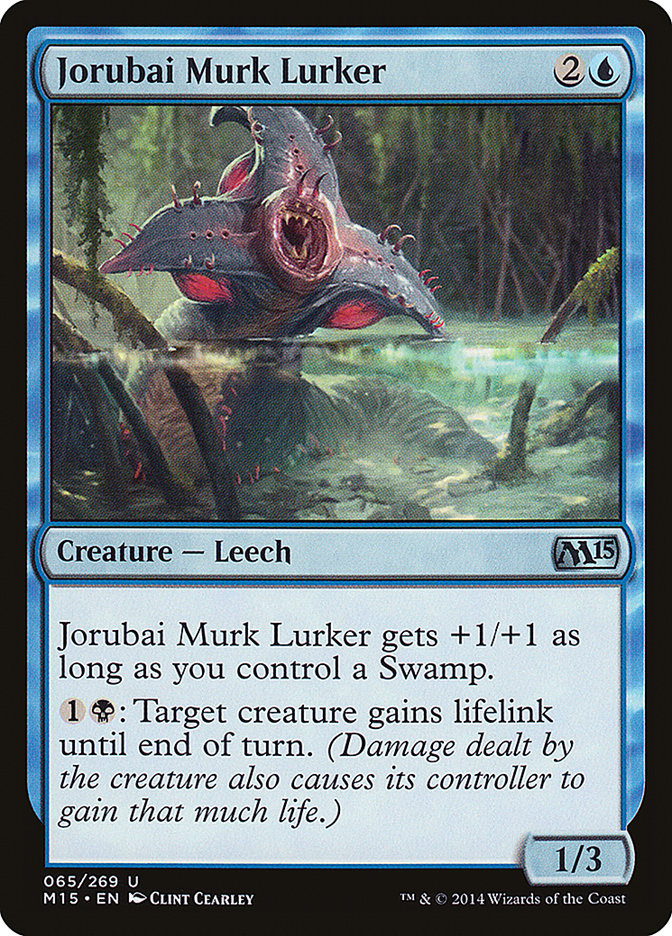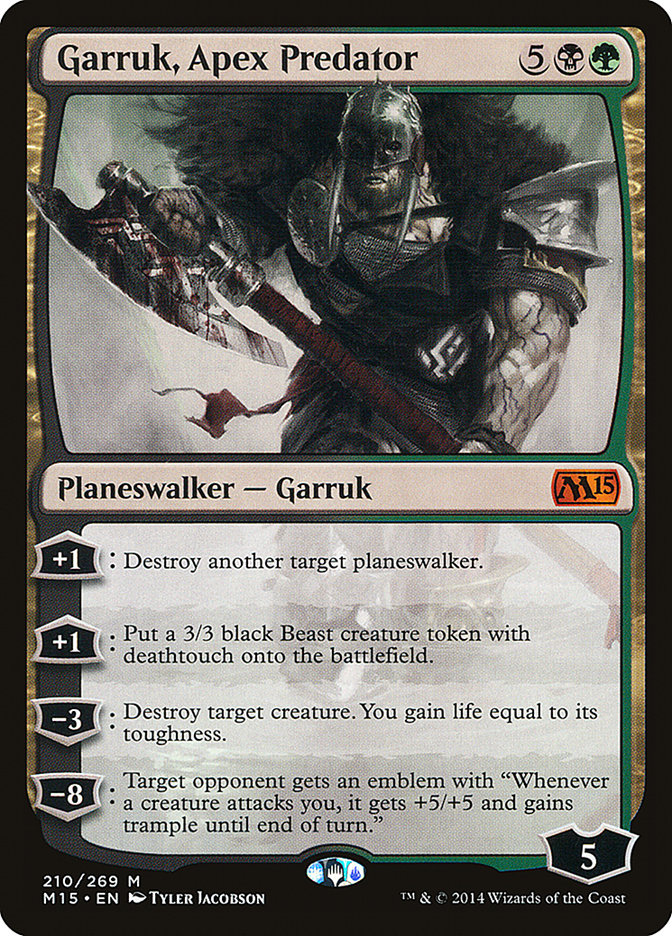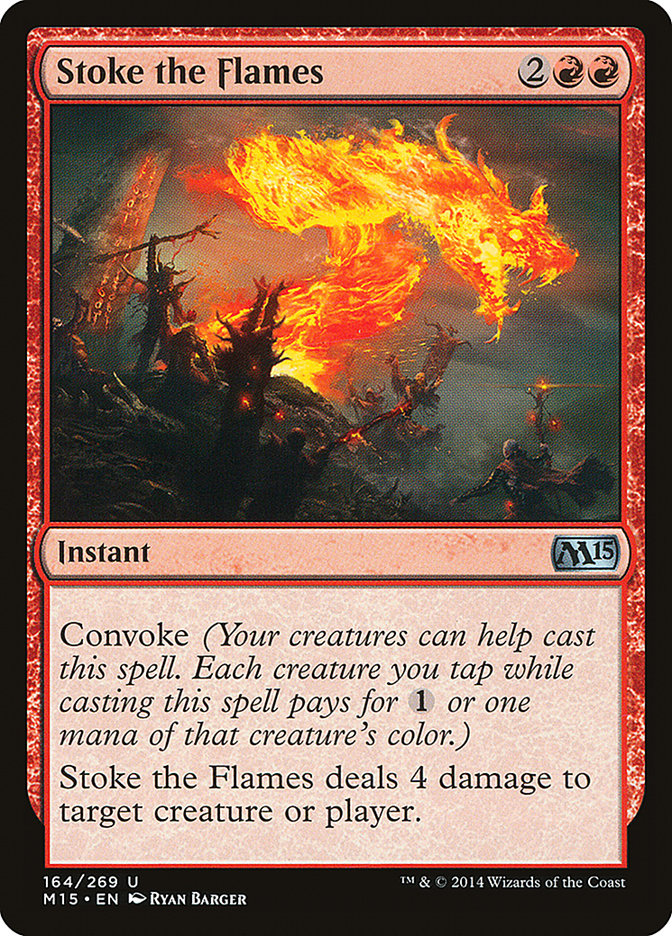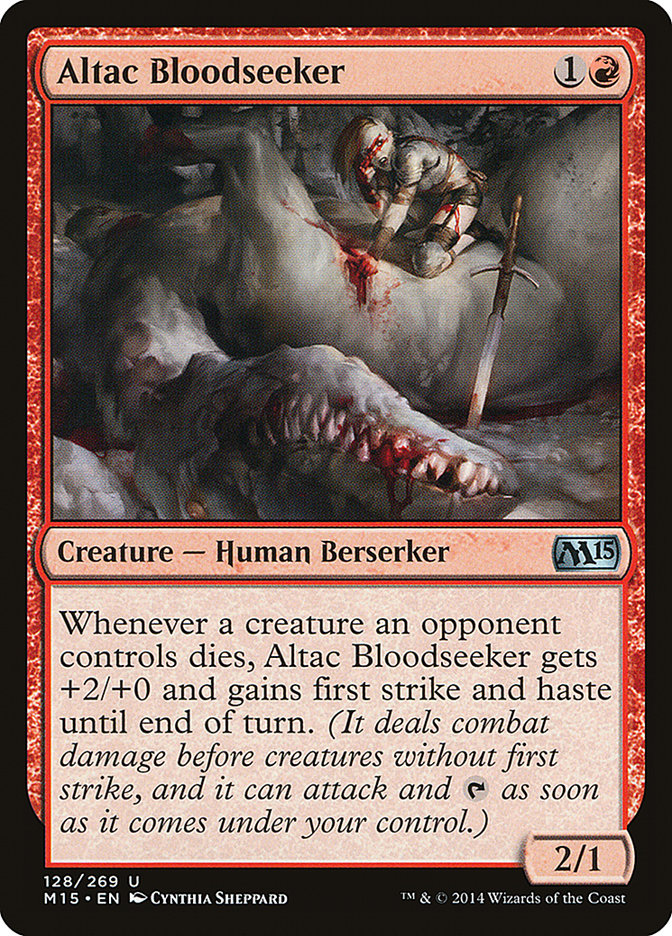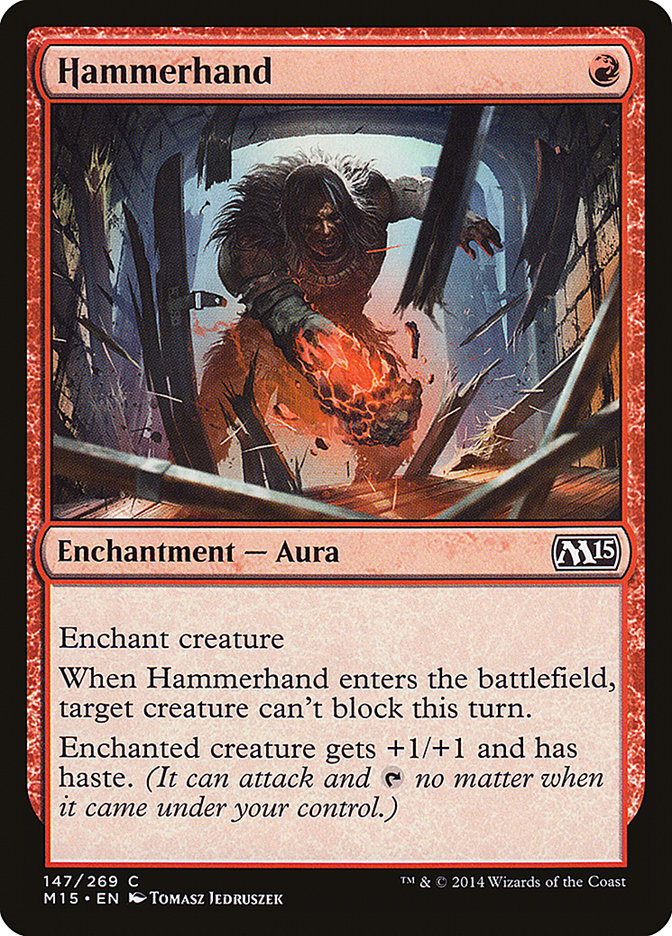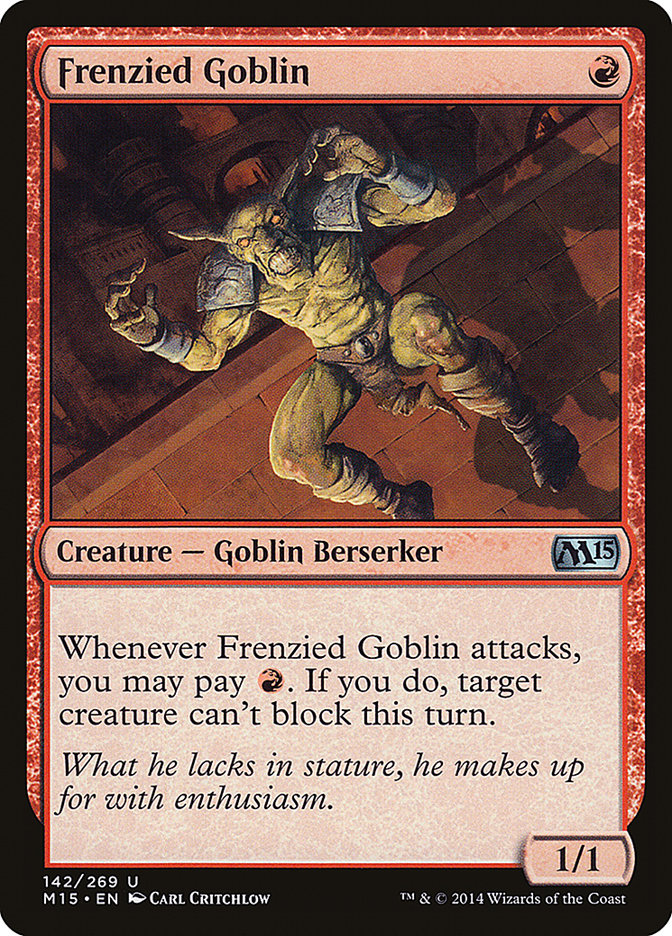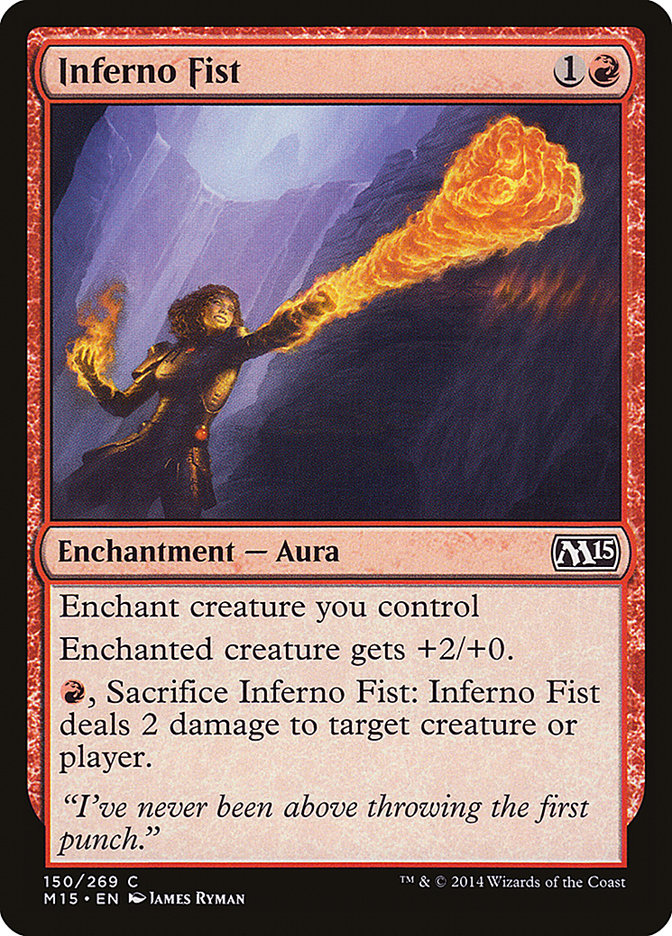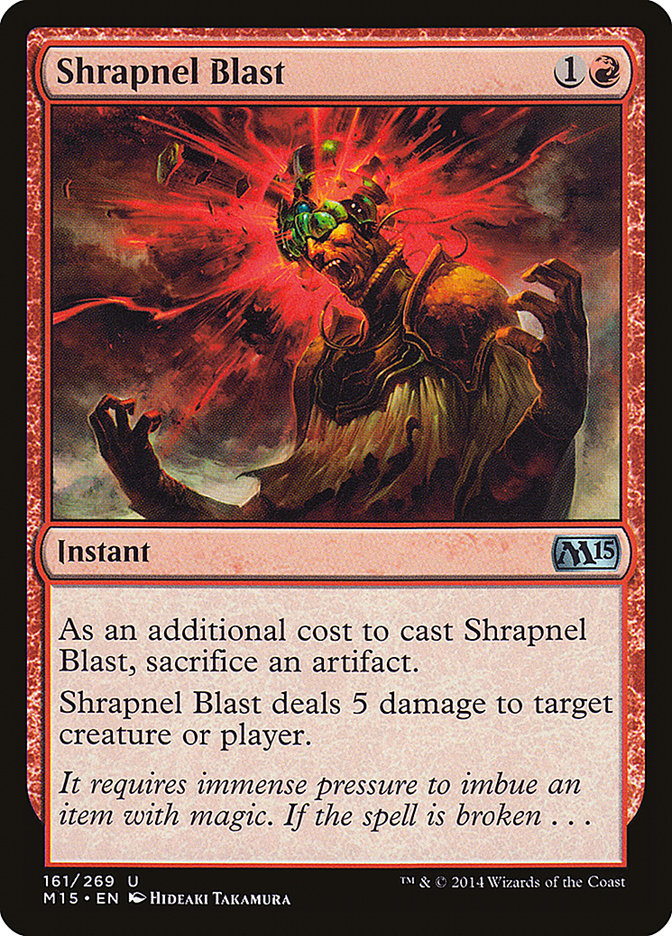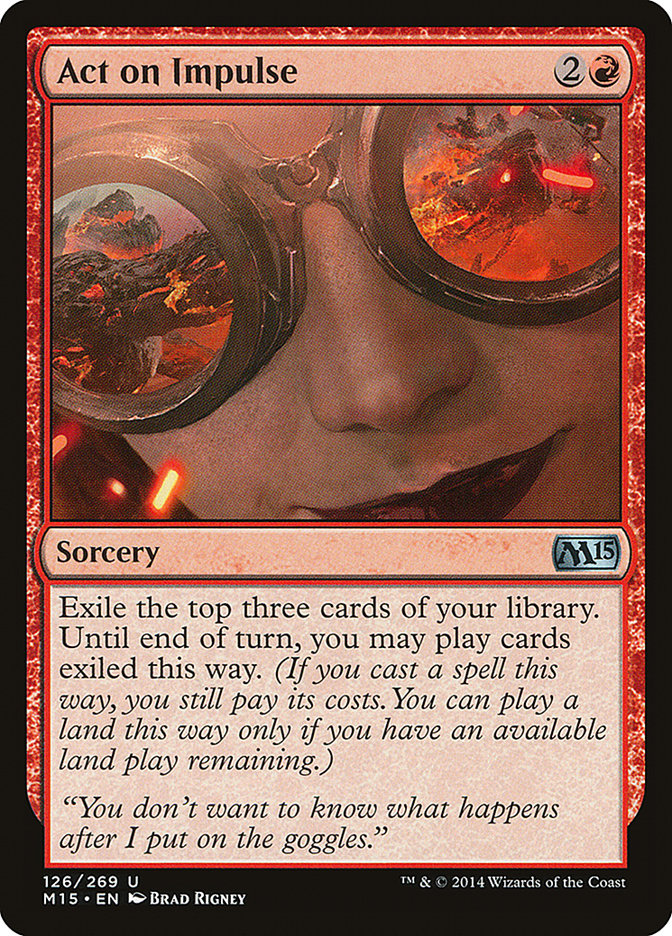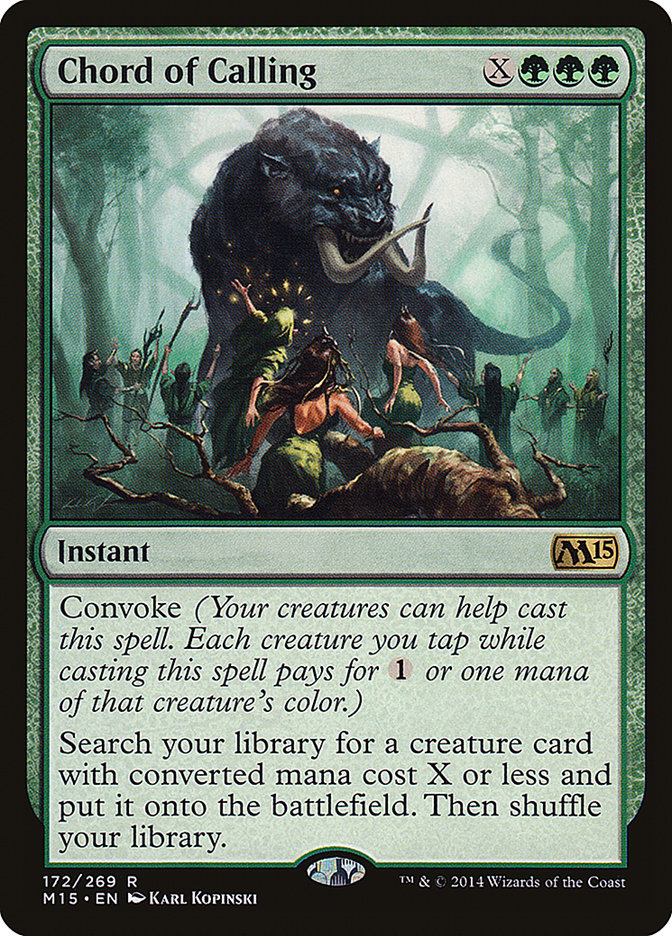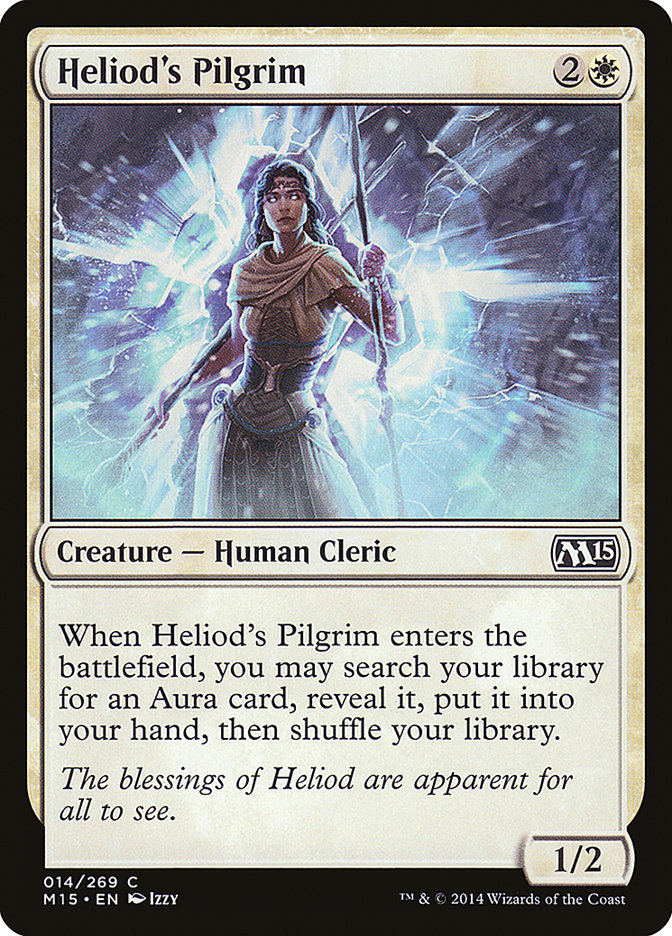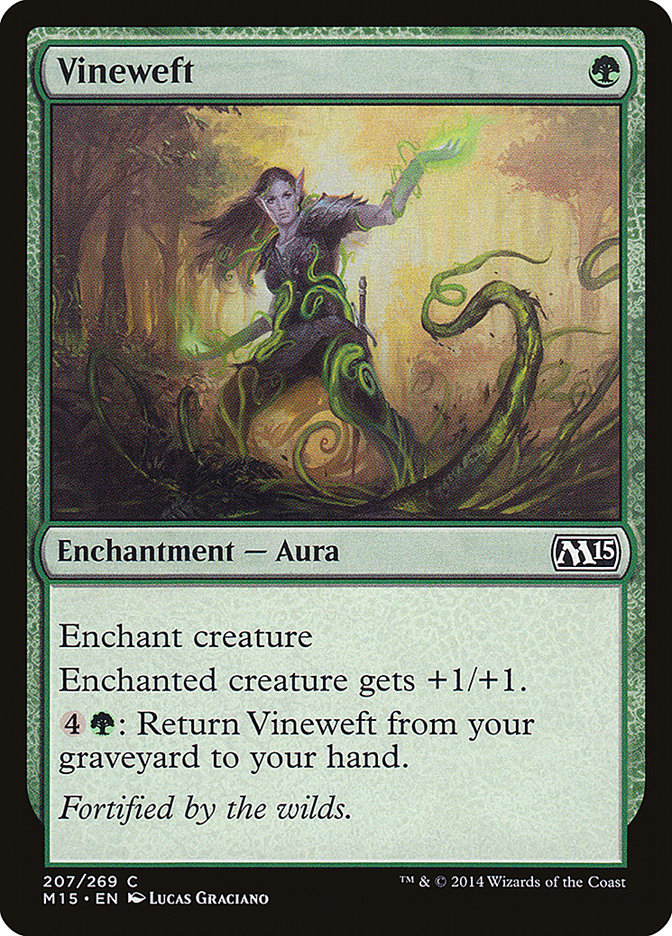So, Magic’s 21 years old…?
This is not the most core-set feeling core set printed in recent years, but it is definitely not short on depth to explore. And as long as the answer isn’t “Yep, Thoughtseize/Thassa/Sphinx’s Revelation again,” I am all for it. It’s a strange feeling, feeling like we’re embarking on a quest to save our land from stagnation, knowing there’s a very real chance we will fail and sink back into the depths of a solved metagame.
However, fear that the journey will end in death can’t stop us. The format needs us, and if we don’t even try, its fate is sealed. At least we have a fighting chance.
What more can we really ask for?
This week, I’m going to take a look at all of the tournament impacting cards in M15. Today, I’m going to start with the existing format, figuring out what fits, what might be worth slightly changing direction, and what’s good against the existing strategies starting with black and red decks. Wednesday, I’ll be back with blue, white, and the rest of the green decks, plus a few new decks made possible (or greatly improved fringe decks) as a result of new tools. Finally, Friday we’ll be in full-on brew mode!
Remember: the key to figuring out new cards is not to “pick the good ones and dismiss the bad or overrated ones,” it’s figuring out how to use all of the new cards. Only then will we have the best understanding for deciding which cards to use and how.
Where to start?
Bet you weren’t expecting that one!
I have heard basically zero said about Jorubai Murk Lurker, aside from “great in limited if you are playing black and blue.” Think of it this way, though. First, in a base black deck, it’s a 2/4 for 1UB. That’s already a pretty respectable body in this format, having resistance to Bile Blight and Lightning Strike, while being excellent at blocking the majority of cheap creatures (with big creatures dealt with by black removal).
The important part of Jorubai Murk Lurker, however, is the ability to grant lifelink all over the place. It’s already not the easiest creature to kill, but if it lives, it can gain you such an absurd amount of life that it can be impossible to race you. At the very least, you can fuel Underworld Connections forever, but beyond that, it provides a very potent trump to the red aggro strategies that have been so popular recently because of their natural strength against black.
Often a red deck won’t even have to tap down a Desecration Demon. The Murk Lurker makes this mandatory every turn. Pack Rats will generally single-handedly take over a game if you have enough time. Murk Lurker does exactly this. Even just giving lifelink to random Gray Merchants and Mutavaults adds up over time and gives you something productive to do with your mana.
Creatures (18)
Lands (24)
Spells (18)

It’s really hard to make room for cards in black devotion decks, but the nice thing about the blue splash is that the blue cards are high impact and the mana easy.
Is Negate what we want in the sideboard? I’m not sure. It’s a nice dimension to add, but it’s really not that different than Duress.
It’s a small point, but Urborg, Tomb of Yawgmoth should be in basically every black deck. It’s just so good with Nightveil Specter or Bile Blight with Mutavault. What’s interesting is if a black deck might use multiple Urborgs if they have Nykthos, Shrine to Nyx. You can even discard your second copy to a Pack Rat…
What color to splash in black devotion (if any) is an interesting puzzle to solve, as there is an argument to be made for each color. Green and white actually have two different paths depending on how far you are willing to go into the color. Red, on the other hand, is probably the least appealing, and gains the least from the new set.
Creatures (15)
Lands (25)
Spells (20)

There really isn’t anything new for B/r, beyond maybe Sign in Blood. If B/r makes a comeback, it will be because of Rakdos’s Return becoming an all-star. I don’t think that’s the world we are heading to, but it is one to watch for.
There were already double green and double white cards that warrant consideration, so the printing of Llanowar Wastes and Caves of Koilos is a particularly interesting factor to consider. The big tension on the other side, however, is that Lifebane Zombie is still legal.
If you’re willing to play double green, you could do something like:
Creatures (15)
Planeswalkers (1)
Lands (24)
Spells (20)
- 2 Forest
- 1 Liliana Vess
- 4 Thoughtseize
- 2 Abrupt Decay
- 4 Underworld Connections
- 4 Hero's Downfall
- 2 Bile Blight
- 1 Silence the Believers
Sideboard

The big reason to play Courser of Kruphix (beyond it just being a fantastic card) is how incredible it is in conjunction with Underworld Connections. The life gain offsets the life loss, and when you don’t have a land on top of your deck, you can use Connections to give yourself extra shots at free cards.
It might just be that Sign in Blood is worth playing anyway, but I am less hot on it when we don’t have Gray Merchant of Asphodel. The Gray Merchants are a little bit of a package deal, and if you cut Nightveil Specter and Lifebane Zombie for green creatures, it starts becoming harder to support it.
It’s not clear to me if Reclamation Sage is worth the maindeck spot, particularly when you could just play Golgari Charm, but it at least warrants consideration. It is fun that Soul of Innistrad can get it back to solve hard problems later.
Speaking of Soul of Innistrad, I think this is one of the most interesting new cards to try for black decks, as it’s a big trump in black semi-mirrors. If you drop it, you are going to absolutely smash a black deck, and even if they have removal or discard to fight it, it will draw you three extra cards. It’s also a mondo-combo with Pack Rat (giving you value while you advance that plan, and giving you a way to get everything back if you get Supreme Verdicted). That said, I think Soul of Innistrad is actually more appealing in versions with actual Gray Merchant, as that is the creature you most want to recurse.
I dunno, man. Isn’t seven mana kind of expensive? I’m interested in working with this guy a little, but Soul of Innistrad seems better in this deck. Garruk has a lot of the power tied up in:
- Not being a creature
- Being an absolute beast against planeswalkers and fatties.
We’ll see if that’s the direction the format is going, but at the moment, I’m not just shoving Garruk in random decks, but I will try to work with this gentleman later in the week.
You don’t need to play double green, however. Splashing green for just Abrupt Decay and maybe Golgari Charm or Vraska the Unseen costs you very little, while not leaving you exposed to Lifebane Zombie.
Creatures (17)
Lands (26)
Spells (17)
Sideboard

Abrupt Decay is a really strong Magic card, no question, but it is particularly valuable to black decks right now because it is early removal (which you need), while also hitting Detention Sphere or Underworld Connections, making it an all-star in match-ups where removal is usually bad. I still like some amount of Bile Blight, however, as you do want answers to Pack Rat, Elspeth tokens, and Mutavault.
The main appeal to both green and white is the enchantment removal, which black greatly appreciates. While white’s enchantment removal is not quite as strong (Decide and Banishing Light vs Abrupt Decay, Golgari Charm, and Vraska), it also gives us the options of Elspeth, Sun’s Champion, Blood Baron of Vizkopa, and Obzedat, Ghost Council.
Creatures (8)
Planeswalkers (2)
Lands (24)
Spells (26)

I think Liliana Vess is a fine card regardless, but she gains a lot of utility in B/W because of how high impact of cards you can potentially tutor for. For instance, Planar Cleansing is an absolutely absurd tutor target against Jund Monsters. Drop Liliana on five, go find it, and even if they kill Liliana, you are going to destroy everything next turn. Your discard makes them want to play out their whole hand anyway, playing right into Planar Cleansing.
If we didn’t play a Planar Cleansing main, I would want at least one, maybe two Banishing Lights. The card isn’t an all-star, but it is a very passable Abrupt Decay alternative, and being able to keep opponents off of Underworld Connections is huge.
Yes, Planar Cleansing does kill our own Connections, but B/W is less reliant on them than other black decks. Besides, the people Connections beats are not usually the people that you tutor for Planar Cleansing against. Even when you do have to blow up your Connections, you are often getting so much out of the Cleansing that it’s worth it.
Playing only one Pack Rat is fairly dubious, but they really aren’t at their best in B/W. B/W’s cards are so individually powerful, you are often discarding cards that could win the game on their own to make more rats. It might still be right to just shove on Pack Rats, but I like exploring moving a little bit away.
Two final notes: I went with 26 land despite having two Sign in Blood and two Read the Bones, since this deck has a lot more expensive bombs than other black decks. Additionally, this build of B/W doesn’t have that many creatures, but if we built a version with more, I’d love to see Spirit Bonds in B/W.
Finally, we come to Mono-Black. Maybe we don’t need all those fancy colors!
Creatures (17)
Lands (26)
Spells (18)

This is a very straightforward, very clean list. Sign in Blood might be too much life loss for some of the other two-color builds, but it really shines in Mono-Black. Soul of Innistrad is also an all-star here, giving us a late-game plan against blue and other black decks (helping making up for the lack of enchantment removal).
Speaking of enchantment removal, Perilous Vault is quite pricey, but worth considering in Mono-Black, particularly if we use Liliana Vess. More and more enchantment removal, these days, can’t hit four-cost artifacts (Abrupt Decay, Golgari Charm, Deicide); and if we can untap with Perilous Vault, we are going to get a lot of the same goodness that Planar Cleansing aspires to above.
I have one copy of Nykthos in here, but that might be too greedy, with the Nightveil Specters. Still, it is quite the mondo combo with Soul of Innistrad, sometimes letting you cast it and return three creatures in the same turn. Even if we don’t want Nykthos, we should at least consider Radiant Fountain instead of the twentieth Swamp. One extra life is not super impressive, but two extra life is starting to represent a very noticeable cushion against aggro decks.
I know the hip thing at the moment is to bash the Souls due to the expensive activation costs, but it’s literally the same thing as Flashback. People always underestimate how good the best Flashback cards are,because of how confusing opportunity cost is. Most cards do nothing in your graveyard so a card that actually has a major impact on the game from your graveyard (drawing three extra cards!) is a very different sort of card than people are used to.
We shall see, though. We shall see.
Black Aggro
While Black/x midrange decks are far more popular, Black Aggro is very real and poised to be even more real after the rotation (given its popularity in block).
Creatures (29)
- 4 Rakdos Cackler
- 4 Lifebane Zombie
- 4 Tormented Hero
- 1 Mogis's Marauder
- 4 Pain Seer
- 4 Herald of Torment
- 3 Spiteful Returned
- 4 Gnarled Scarhide
- 1 Cruel Sadist
Lands (22)
Spells (9)
Sideboard

Unfortunately, it doesn’t gain a ton in M15, though we should try at least one copy of Cruel Sadist in case the card turns out to be a sleeper. I am not blown away when I read it, but it is a one-drop that can actually have a meaningful impact on the board. His kill ability isn’t particularly exciting, however, growing every turn without having to get into combat is something. Once Rakdos Cackler rotates out, we’re going to be in the market for another one-drop anyway…
Stain the Mind is actually kind of sweet out of the sideboard, though. Obviously on the surface, you can name Supreme Verdict, crippling counterplay, but even better is to Thoughtseize their Verdict, then remove their Sphinx’s Revelations. Without the Sphinx, it’s going to be very hard for a lot of people to get enough advantage to win.
As cool as these plays sound, it is not free. Stain the Mind will often cost three mana and two attacks. Each one-drop you play that turn is effectively free, but it’s going to be hard to not miss a noticeable amount of damage.
Black aggro might also want to consider Ulcerate or Crippling Blight, but neither calls out to me yet. Ulcerate is obviously a hot option if we want to be as fast as possible, but it is competing with Bile Blight. It’s probably at its best if we play some ultra-fast aggro deck, possibly two-colors to get even more two-power one-drops.
Crippling Blight was once technology against Thragtusk. Nothing like that really exists in the format, but it’s a card to remember if blocking becomes more popular. It’s generally worse than Mogis’s Marauder, so I wouldn’t hold my breath on it.
Red Aggro
Red aggro has experienced a renaissance of sorts, having natural advantages against black decks and three-color control. They really suffer against decks like Blue Devotion or Courser of Kruphix/Polukranos decks, but they have a lot of new options in M15. As is so often the case, none of the options are that powerful, and generally we’d rather have quality than quantity, but red decks are often underpowered anyway. This doesn’t mean they aren’t good, it just means they aren’t winning most of their games on raw card quality.
Red aggro is sharply divided between the weenies and the burn. Often people will play all of one and almost none of the other. Stoke the Flames is particularly exciting because it suggests a mix of both.
It’s not the most breathtaking rate, by any means, but it does pack a punch compared to most of our burn options like Shock and Lightning Strike while still being castable in a low-curve deck. Because you can tap creatures the turn you played them, Stoke the Flames is usually effectively just two or three cost without missing any damage.
Creatures (24)
- 4 Chandra's Phoenix
- 4 Ash Zealot
- 4 Rakdos Cackler
- 4 Young Pyromancer
- 2 Stormbreath Dragon
- 4 Firedrinker Satyr
- 2 Prophetic Flamespeaker
Lands (4)
Spells (32)

Young Pyromancer has perfect synergy with Stoke the Flames, asking you to play more sorceries and instants while also providing you with a supply of tokens to let you Stoke on the cheap (or for free!).
One card I did not include any copies of, but that should be kept in mind is this number right here:
If the metagame becomes populated with a lot of creature decks, Altac Bloodseeker goes from playable to great quickly. The value of haste is obvious, but the first strike ability is equally important. You can attack with the Bloodseeker and if an opponent tries to block, Lightning Strikes quickly become two-for-ones.
It’s worth noting, if some kind of a Rakdos aggro deck emerges, Bile Blight + Altac Bloodseeker gets crazy fast. Opponent was planning on blocking with those three Elspeth tokens or those Pack Rats? Suddenly they lose everything and take eight plus however much the rest of your creatures deal.
What about:
The perfect card for everyone that’s been playing Ghor-House Chainwalker in their Burning-Tree Emissary decks. That’s about it, though.
Deciding how many lands to play in red decks is confusing. I love what Stormbreath Dragon does for us, but if we didn’t play it, we could definitely shave another land for another burn spell.
Prophetic Flamespeaker might not be the right way, but I kind of want to try it in a lot more decks. The card really impressed me in block, even if it was not a great fit in the popular decks.
What I’d really like to do is find a red deck that can use Prophetic Flamespeaker and this card:
Hammerhand is just a sweet card in its own right, good in ways people are not used to, making it an ideal candidate to pick as a sleeper. Putting Hammerhand on a Prophetic Flamespeaker can be pretty hot, particularly if you still have a leftover mana and haven’t play a land yet. Even if you’re Flamespeaker was already in play, removing a blocker while giving a doublestriker a stat boost is a lot of action.
One of the challenges to using Hammerhand is that it is not a sorcery or instant, taking away from potential synergies with Young Pyromancer and Chandra’s Phoenix, and sorceries and instants are the exact type of cards that usually work well with the Flamespeaker.
The most obvious home for Hammerhand is red heroic, which should snap-include the full playset:
Creatures (29)
Spells (31)

Prophetic Flamespeaker is too high on the curve for such an all-in assault, but we are not short on ways to make Hammerhand strong. I mean, the card is just fine on its own, but combining it with either heroic one-drop leads to incredibly explosive openings.
That is so many one-drops! This is going to leave us very vulnerable to sideboard cards like Drown in Sorrow or Anger of the Gods, but we are going to explode out of the gates.
On the topic of one-drops, M15 has a new one I am very excited about:
This little guy was instrumental to Mark Herberholz winning the first Pro Tour Honolulu with his innovative take on R/G Aggro.

Being able to remove a blocker each turn has a big impact on the game, helping shore up a weakness to fatties that plagues this sort of deck. It even solves difficult problems such as a Fiendslayer Paladin on defense. Remember, the Paladin doesn’t have Protection from Red, and can still be Frenzied out.
Frenzied Goblin’s biggest weakness is Mutavault since it can’t actually hit a Mutavault under most circumstances while being easy to eat. Decks with Shock and Searing Blood won’t mind, but Red Heroic is generally built without much burn, if any. Fortunately, Rubblebelt Maaka is an awesome way to blow someone out that tries such a defense, and Madcap Skills and Dragon Mantle provide ways for the Goblin to keep attacking.
Inferno Fist could also work, letting you keep the pressure on, while threatening to kill any Mutavaults that pop up. I’m kind of down on Inferno Fist though, as this is a lot of mana for a minor effect, particularly when we only have 16 land in the first place.
What about all that stuff you said about the Souls and opportunity cost?
Look, if Inferno Fist could be flashed back at instant speed out of your graveyard rather than sacrificed from play, I’d be all about it. The Souls give you something you want after your opponent already dealt with a hard problem. Inferno Fist gives you something minor you might want if you are willing to give up the other minor thing you might want that it gave you. It gives you one or the other at a time, while the Souls give you both.
On the other end of the spectrum, we have R/W Burn:
Creatures (8)
Lands (16)
Spells (36)

Battlefield Forge makes splashing Chained to the Rocks even easier than before. This isn’t just true for R/w Burn, either. It is totally reasonable to run the same sort of splash in a more traditional red aggro deck, particularly if we’re struggling with large creatures.
Stoke the Flames isn’t as good without lots of creatures to free-roll off of, but it might still be worth playing the playset. Boros Charm, Warleader’s Helix, and Stoke the Flames is an awful lot of cards that can kill in five shots rather than seven.
What about the biggest burn spell in M15?
Shrapnel Blast is definitely a very potent card, but there’s just not a lot of support for it yet. Yes, you can play Darksteel Citadel, but that already pushes up against Mutavault
Creatures (7)
Lands (16)
Spells (37)

I guess you could Phyrexian Revoker, but I wouldn’t want to go that way unless I was playing a lot more creatures. I’m sure there will be more artifacts printed in Khans of Tarkir, presumably as some sort of a UWR flipside to Esper. By then, Mutavault will have rotated, making Darksteel Citadel less of a cost. In the meantime, I’m off it.
I gotta admit, though, Eidolon of the Great Revel is cute with Stoke the Flames…
No Act on Impulse?
“You don’t want to know what happens after I put on the goggles.”
This is a challenging one to evaluate, as it is a different type of card than red has had historically. Still, it doesn’t seem particularly promising in red aggro creature decks. It’s not a three-drop, as much as it is a five-drop (at the very least), maybe even a six or seven-drop.
Maybe a Burn deck can make use of it, but I think its real use is in a different sort of deck entirely (and possibly in smaller numbers). This card’s interesting, but I don’t see it in red aggro any more than I see Divination in Blue Devotion.
Of course red creatures and red burn are not the full picture. What about Red Devotion?
Creatures (28)
- 4 Frostburn Weird
- 4 Burning-Tree Emissary
- 4 Boros Reckoner
- 1 Purphoros, God of the Forge
- 4 Stormbreath Dragon
- 4 Fanatic of Mogis
- 4 Eidolon of the Great Revel
- 3 Soul of Shandalar
Lands (18)
Spells (14)

Soul of Shandalar is a perfect fit in red devotion, giving you something epic to do with all that Nykthos mana. It gives you added resilience against black removal, and can totally take over games where it lives. You’ve even got enough creatures that opponents could easily have none left when you drop it.
Adding three Souls of Shandalar does up our curve a lot, and this list tries to help ease that with a higher total land count. I’m not sure we can really get away with Mutavaults, but it’s such a ridiculous card, I sure do want to try. This is definitely the more ambitious approach, and if I were playing this deck in a tournament tomorrow, I might cut the third Soul for a Chandra or another Purphoros.
Jund Monsters
As long as Lifebane Zombie is in the format, it’s hard for me to get too into this strategy. It’s not even that powerful in the abstract, and it is exactly the sort of also-ran strategy that makes Blue Devotion look good. It’s not like the deck is bad per se. Every Standard deck at the moment is medium. It’s just that some decks are more medium than others…
Creatures (25)
- 3 Scavenging Ooze
- 2 Ghor-Clan Rampager
- 4 Elvish Mystic
- 3 Polukranos, World Eater
- 4 Sylvan Caryatid
- 4 Stormbreath Dragon
- 3 Courser of Kruphix
- 2 Soul of Shandalar
Planeswalkers (7)
Lands (20)
Spells (8)

Soul of Shandalar is going to surprise some people. I particularly like that it’s not green (or white) for anti-Lifebane-iness. Opposing removal spells are going to be overworked anyway, and if they kill your Polukranos and Stormbreath Dragon, they might not be able to deal with the Avatar. If you get to untap with it, it will quickly demolish most boards and is basically unstoppable in combat. Even if they can deal with it, you still get respectable value out of it and at a very reasonable mana cost, particularly if it kills a Jace, Architect of Thought or Nightveil Specter.
Remember to sideboard out Ghor-Clan Rampagers and Polukranos against Lifebane Zombie types! There are enough alternative threats that it really is no problem.
Jund Monsters doesn’t gain much else from M15. You can add some Llanowar Wastes in there, if you want, but I like Overgrown Tomb better in general. Reclamation Sage is a fine sideboard card, but that wasn’t really our weakness, as we already had access to Abrupt Decay, Golgari Charm, Unravel the Aether, and Destructive Revelry
Back to Nature is more narrow, but at least it’s a specialized tracebuster that can totally blow out a Constellation or Hexproof deck. Our only enchantments are a few Courser of Kruphixes, so it really will be one-sided. This card is a very strong sideboard option, and while most decks use too many enchantments to want this, if you don’t, you should really consider it. It is the definition of high impact.
B/G Graveyard
Dredgevine, Constellation, Reanimator, Chord of Calling, there’s so many ways to go with this sort of strategy. The one I want to work with first is Chord of Calling, since these decks already featured so many one-ofs.
Creatures (31)
- 1 Scavenging Ooze
- 1 Jarad, Golgari Lich Lord
- 1 Deathrite Shaman
- 4 Elvish Mystic
- 1 Shadowborn Demon
- 1 Polukranos, World Eater
- 3 Sylvan Caryatid
- 2 Nighthowler
- 1 Nylea's Disciple
- 4 Satyr Wayfinder
- 1 Eidolon of Blossoms
- 1 Doomwake Giant
- 1 Pharika, God of Affliction
- 4 Nyx Weaver
- 1 Brain Maggot
- 1 Yisan, the Wanderer Bard
- 2 Soul of Innistrad
- 1 Reclamation Sage
Lands (16)
Spells (13)

This list is among the furthest from tuned, but there’s just so many cards to try! Llanowar Wastes is exactly what this deck needed, as it seeks to keep its land count low, while needing more untapped mana of both colors.
This card is great! It’s far from free, but it is well worth all of the praise and attention it’s receiving. We’ll definitely be doing more with Chord of Calling later in the week, but I think it can work here as well. Decks with dorks like Satyr Wayfinder benefit from it even more than usual, plus if you just ever plan on threatening to block, you can often get it for free. There are a lot of great options for a toolbox at the moment, and going long, it is a huge threat against control (on their end step get Soul of Innistrad, then untap and draw three).
Soul of Innistrad is a really powerful card on its own, but when you have Satyr Wayfinders, Nyx Weavers, Grisly Salvages, and Commune with Natures, you are going to flip it incidentally, which will basically just annihilate black decks. Building towards this interaction is one of the most interesting areas of exploration in the format to come. I mean, maybe people start playing graveyard hate, but at the moment, that plan is real hard to beat going long. You might even be able to power through Sphinx’s Revelation decks that think they have “gone off.”
Yisan, the Wanderer Bard is likely too cute, coming at too high a mana cost considering how many other things we have to spend mana on. Still, it plays right into the toolbox we designed for Chord of Calling. If it lives, it is basically drawing an extra card a turn. Spending three mana for a Deathrite Shaman isn’t the most exciting even as a cantrip, but it quickly improves from there. Besides, casting creatures at instant speed is pretty sick, finding surprise blockers, a Reclamation Sage to pop a Detention Sphere, or maybe just getting Brain Maggot during your opponent’s drawstep to timewalk them.
Necromancer’s Stockpile is certainly an option, but it takes us down a different enough path, I want to save it for later in the week. There are actually quite a few weird enchantments we need to consider for these decks, which is great. There is so much richness of depth in this part of Standard.
Endless Obedience isn’t demanding to be played, but if we’re trying to build an actual Reanimator deck, it lets us avoid having to splash white for Obzedat’s Aid. It also has real chances of being a four-cost reanimation spell, and in Magical Christmas land, it can fire on turn 3.
Naya Hexproof
Naya Hexproof is such an odd duck in Standard. It has a very real purpose for existing, but boy does it play loose cards. Still, that’s the way it often goes for synergy decks.
Creatures (15)
Lands (23)
Spells (22)

Hexproof has been a creature short of what it wants for a while, often using Voice of Resurgence only from not having options that fit better with its strategy. I’m not sure the rate is good enough, but Heliod’s Pilgrim is worth a shot.
The key is that it can find Chained to the Rocks against fast decks while threatening to get Spectra Ward or Dragon Mantle against slower decks. That’s a lot of utility, plus it provides a chump blocker or a body to throw extra auras on.
Once you are playing Heliod’s Pilgrim, I think Hammerhand is, at the minimum, a good one-of. We might just want more, though. I also would want to try Battle Mastery. Sometimes we’re going to play a Gladecover Scout on one, a Madcap Skills on two, a Heliod Pilgrim on three, and an Ethereal Armor and Battle Mastery on four. That’s exactly twenty, not counting the Pilgrim…
I didn’t use any, but Vineweft is an interesting card to think about. Is has graveyard interactions, hexproof implications, and can trigger Constellation repeatedly. Is there a convergence, somehow? It just costs so much…
While Hexproof has some new tricks, Back to Nature could prove to be a serious problem. It doesn’t stop the creatures themselves, but it sure does neuter them, not to mention unchaining everyone from whatever rocks they may have been attached to.
Alright, I’m out for today. We’ve still got so much ground to cover, so hit me back on Wednesday. With so many cards to discuss, so many possible decks to work with, I will be turning to the comments to see which cards and decks people want to see most. You guys rock. See you Wednesday!

